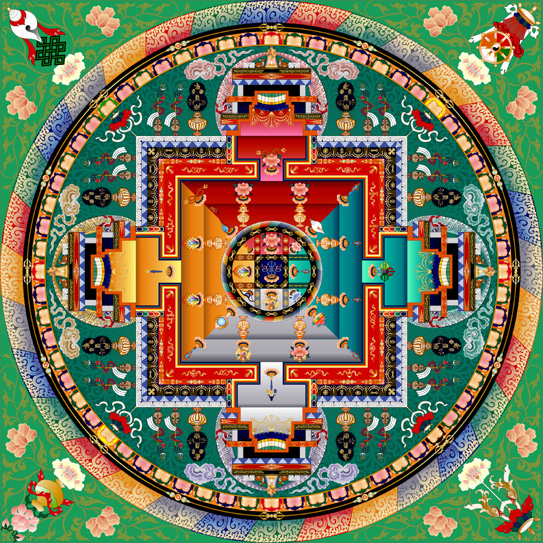
 |
Today, some
say that our feelings and intelligence began as the instinctual animal
fear of death. Supposedly, our civilization and intelligence is based on
some huge hope-and-fear complex. However, this overly simplistic notion
is not the motivating force behind all those thousands of deities that
we find in the various Buddhist mandala cities. As mentioned above, since
the Mahayana Renaissance (from the first century), Buddhist thinkers have
had more profound reasons to recursively multiply all these deities, like
the vast host of characters we find integrated into the Garba mandala and
Vajra mandala of Vairocana.
|
| Due to the
unrelenting evolutionary path of Indian thinking, we see a progression
of mandalas, each more sublime than the last. The Guhyasamaja mandala,
the Chakrasamvara mandala, and the Kalachakra mandala all flowered by virtue
of this impetus. The so-called Tantrayana Buddhists planned these mandalas
as metaphorical doorways to the "store base of consciousness" itself, a
receptacle so vast as to include pure and dirty memories, love and hate,
and every other duality that one can imagine. The creators of the mandala
system urge us to rise above the trap of all dualities.
|
 |
In the Guhyasamaja
mandala system (completed by the eighth century?), we encounter five essential
Buddhas again, four directional ones and one in center. Indeed, the five
Buddha system bears a resemblance to the Vajra-mandala that we saw in the
"Tip of the Thunderbolt"; however, in the Guhyasamaja, the central deity
is not Vairocana but a revolutionarily form of Akshobhya. Akshobhya is
the symbol of "consciousness" in this five aggregate system. The others
are Vairochana (form) in the east, Ratnasambhava (feeling) in the south;
Amitabha (discernment) in the west, and Amoghasiddhi (compositional factors)
in the north. So why would Akshobhya ("consciousness") be assigned the
center position of the mandala? One possible reason could be for Akshobhya
to function as the final witness of the yogic soliloquy. "Cognition-only"
bootstraps to the fore and Akshobhya logs-in as root to the "store base
of consciousness."
|